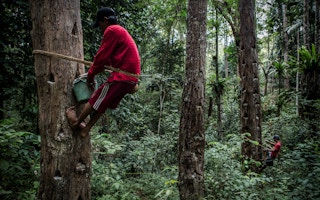A coalition of conservation and business groups is calling for governments and companies to adopt a global ‘nature positive’ goal of having more of the natural world left in 2030, but critics say the aim is too vague and may be open to abuse.
From deforestation and pollution to overfishing, human actions are causing often irreversible biodiversity loss, while eroding nature’s ability to absorb planet-heating carbon dioxide emissions and ward off the worst of global warming.
The Nature Positive Initiative aims to create a collective mission around nature, much like the 2015 UN Paris Agreement to limit global warming to 1.5 degrees Celsius that sent a signal to policymakers, markets and the public, said Eva Zabey, CEO of Business for Nature, a corporate coalition.
Originally launched at COP15 UN nature talks in Montreal last December, campaigners now want to put some meat on the bones - to better define their goals and how companies and other institutions measure their contributions towards them.
“Ultimately, it’s about strengthening our accountability systems in order to be able to increasingly make sure companies are held responsible for their impacts on nature and biodiversity,” Zabey said.
But critics say the terms of nature positive are unclear and could be used to offset destruction in one place with restoration in another, like some companies use carbon markets to reach ‘net zero’ instead of cutting their own emissions.
Nature’s answer to net zero?
Despite the involvement of large conservation organisations like WWF and the International Union for Conservation of Nature (IUCN), some campaigners doubt the power of nature positive as a tool to stem environmental destruction.
Marília Monteiro Silva, senior portfolio manager in nature finance at Greenpeace International, believes it is a “problematic” concept as the term is being used before there is a “clear and aligned understanding” of what it means.
“
We can’t solve these problems by just protecting wild nature. All analysis shows that we have to protect wild nature and we have to change our supply chains - and this net argument is fundamental to that.
EJ Milner-Gulland, professor, University of Oxford
Silva said biodiversity was too complex to measure in a similar way to carbon emissions, and that doing so neglected nature’s intrinsic value.
“You’re basically talking about measuring what is unmeasurable,” she said.
But those involved with the initiative say companies must avoid and reduce their own damage before looking to increase nature elsewhere and transform how they interact with nature more broadly.
“We need to hold people to account, particularly for irreplaceable parts of nature,” said E.J. Milner-Gulland, professor of biodiversity at the University of Oxford and co-lead of the Nature Positive Universities network.
But she said organisations and companies her team had analysed would eventually need to offset a significant portion of their environmental impacts, even if strong actions were taken to avoid and reduce them first.
“We can’t solve these problems by just protecting wild nature,” she said. “All analysis shows that we have to protect wild nature and we have to change our supply chains - and this net argument is fundamental to that.”
She said work was being done to create standardised biodiversity metrics which were appropriate to local contexts, but could be compared at scale, such as the Accounting for Nature framework developed in Australia.
Can nature positive create accountability?
A major challenge facing the Nature Positive Initiative is the potential for its dilution by companies looking to use the slogan, but not transform how they operate in practice.
Marco Lambertini, special envoy for WWF International, said it was not meant to be a buzzword, but a measurable global goal to “inject a clear, high level of accountability”.
He said many companies had been cautious in embracing it in the absence of clear guidance, but initiative partners were releasing more resources on how to disclose and take action on nature impacts.
Last month, Business for Nature and the World Business Council for Sustainable Development, for example, worked with the World Economic Forum and published guides for companies in 12 different sectors.
Meanwhile, an international working group of business and finance executives launched a set of guidelines from the Taskforce on Nature-Related Financial Disclosure for companies to report their nature-related risks and impacts.
Lambertini said biodiversity was “by definition local”, meaning restoration work must be local too, such as regenerating a degraded area of the Amazon rainforest.
That, he argued, could make it easier to ascertain whether efforts to protect it were doing what they promised.
“It has to be like for like. It has to be local compensation,” he said.
But many companies have a long way to go to even understand the effects of their operations and sourcing on nature.
Marissa Balfour, a corporate engagement advisor at US-based non-profit The Nature Conservancy, said she was surprised by the lack of visibility companies had throughout their supply chains when she worked in the textile and apparel industry.
“A huge barrier is lack of traceability into a company’s value chains,” she said, particularly for the raw material stage - which is where the largest impacts on nature tend to happen.
Balfour explained there was now real pressure on companies to obtain this information and act on it, which will take significant investment, time and expertise, as well as genuine interaction with Indigenous peoples and local communities.
“But that’s absolutely the path that everyone needs to be on at this point,” she said.
This story was published with permission from Thomson Reuters Foundation, the charitable arm of Thomson Reuters, that covers humanitarian news, climate change, resilience, women’s rights, trafficking and property rights. Visit https://www.context.news/.










